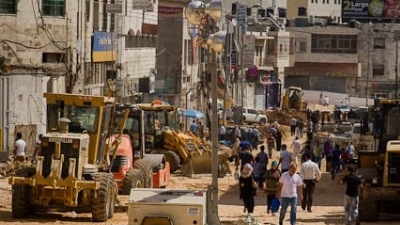Challenge
In recent years there has been little progress on the Palestinian-Israeli political dialogue. The Government of Israel (GOI) continues to control Area C [1], which covers about 60 percent of the West Bank, and access to Gaza. Most consumer goods and many intermediate inputs are allowed entry into Gaza, but most construction material is restricted. Differences within Palestinian polity are not yet resolved.
Against a backdrop of declining donor support and the associated fiscal difficulties, the Palestinian economy has recently slowed down significantly after growing at an annual rate of 11 percent during 2010-2011, to 5.9 percent in 2012. This has been due mainly to the ongoing Israeli restrictions [2] and the fiscal retrenchment caused by a decline in donor funding and increased political uncertainty. Civil servants’ salaries were delayed several times during 2012. The Palestinian Authority’s (PA) current fiscal situation is challenging in view of the projected fiscal deficit for 2013 (estimated at US$1.05bn).
Solution
The Bank has maintained an active program in the West Bank and Gaza (WB&G). Its analytical and advisory activities provide policy advice in sectors prioritized by the PA’s own National Development Plan (NDP). It reports to the donors of the PA on economic development issues. The Bank has a two-pronged approach of budget support and investment operations. Development Policy Grants support the PA’s reform program in fiscal management and public financial management and provide budget support while investment projects support water, urban and social protection sectors, among others. The Bank’s portfolio leverages 3.5 times its size from donor contributions. Additionally, approximately US$200 million is disbursed annually through donor contributions to the Palestinian Reform and Development Plan Multi-Donor Trust Fund (PRDP MDTF).
The World Bank Palestinian portfolio has maintained a high level of adaptability in order to be able to respond to the fragile environment. In addition to the PA at the apex level, the Bank supports municipalities and Non-Governmental Organizations (NGOs) to strengthen institutions and improve service delivery.
Results
Public financial management and fiscal management have improved through a reform program supported by the Bank’s Development Policy Grant (DPG) series. Progress has been made on controlling the public sector wage bill (a reduction from 22% in 2009 to 17% in 2012) and taking steps to reduce net lending. A computerized financial management system was introduced in all line ministries to make financing reporting more transparent. The internal audit process has been strengthened, and a new legal framework for public procurement was introduced. The targeting of social assistance programs has been improved to ensure the funding reaches the extremely poor and vulnerable. The cash transfer program is now a regional example of good targeting and outreach to poor populations, skills training of social workers, and maintenance of an up-to-date poverty database.
In the urban sector, the PA established the Municipal Development and Lending Fund (MDLF) in 2005 to address financing and capacity building of municipalities and for channeling development assistance to municipalities. The MDLF implemented several municipal reforms with the support of donor financed projects, to strengthen local government through greater fiscal and administrative autonomy. The MDP1 reached all 134 municipalities in the West Bank and Gaza, thereby indirectly benefitting approximately 3 million in total population (49% females) by March 2013.
The Cash Transfer Program, supported by the World Bank, replaced an earlier complex web of social protection initiatives implemented by different players and more than doubled the number of beneficiaries reached from 2010 to 2012. In 2012, it reached over 100,000 poor households covering more than half of the poorest quintile and devoting two thirds of its resources to the extremely poor. An assessment conducted in 2012 found that the cash transfer program’s proxy means targeting correctly identified more than 70 percent of all cases, limiting the exclusion and inclusion errors to acceptable levels of around 20 percent. The program represents international good practice in terms of its impact – with measurable reductions in inequality and poverty -- as well as coverage and targeting.
Bank Group Contribution
The Trust Fund for Gaza and the West Bank (TFGWB), established in 1993, provides financial assistance to WB&G. Not being a member of either the IMF or of the World Bank makes the West Bank and Gaza ineligible for the sources of financing normally available to member countries. TFGWB has been replenished 11 times since its inception in the amount of US$805 million. The investment operations portfolio is financed from the TFGWB, the Institutional Development Fund and the State-Building Peace Fund (SPF). The portfolio size was US$154m as of March 31, 2013, with the undisbursed balance of US$58.5m. Projects in the portfolio cover a range of sectors, from urban development and water, to social protection and education. Most projects in the portfolio leverage donor funding, along with the TFGWB contributions – on average 3.5 times the size of World Bank funding.
The World Bank administers the PRDP MDTF. Since its establishment in 2008, the PRDP MDTF has disbursed nearly US$1.0bn against implementation of key aspects of the NDP relating to budget execution and the maintenance of a sound macroeconomic framework. The donors currently supporting the PRDP MDTF are: Australia, France, Japan, Kuwait, Norway, and the United Kingdom (UK).
The International Finance Corporation (IFC) maintains an active investment and advisory program in the West Bank and Gaza and its total commitment is US$163.4m. The IFC focuses mostly on the finance and insurance, information and education services sectors, which account for 99 percent of the total commitment. The Multilateral Investment Guarantee Agency has five active projects with a total exposure of US$14.7m.
